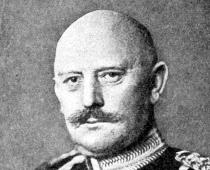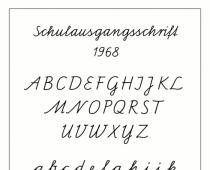Who and how compiled a reference book about the security officers of the era of the Great Terror, and why it is important
Thorough work by Andrei Zhukov “Personnel composition of state security bodies of the USSR. 1935-1939" (nkvd.memo.ru) contains brief information about more than 40,000 NKVD employees who received special ranks of the state security system. These “awards” were awarded for the persecution of “enemies of the people,” and the vast majority of those “awarded” were related to the organization and execution of repression. The source of the information in the directory was NKVD orders on personnel, indicating the numbers and dates of assignment of special ranks, positions held or dismissal from the NKVD. They are supplemented by biographical data from other sources - primarily from documents of victims of repression. Andrei Zhukov's directory was published in May of this year on CD. By the time the electronic version appeared, information had already been added to 4500 biographical information. The creators of the project are confident that Internet users will also actively participate in the process of studying and adding to the history of the era of the Great Terror.
Yan Rachinsky, member of the board of the Moscow Memorial:
— A reference book about the security officers of the era of the Great Terror is the work of an independent researcher Andrei Nikolaevich Zhukov. For more than 15 years, he painstakingly collected information and compiled card files when there were no computers and databases. Ultimately, he set himself the task of collecting information about everyone who received the special state security ranks introduced in 1935, shortly before the Great Terror. These were not only employees of the Main Directorate of State Security, but representatives of other structures for the prosecution of so-called “enemies of the people.”
The directory covers the period from 35 to 41 and contains the names of more than 40,000 people, the main creators and perpetrators of the Great Terror. But not only them. Almost all the executioners are in this directory, but everyone who is there is an executioner.
This is a huge undertaking and a starting point for refinement and further research. The directory helps you find a specific person and connect him with specific events described in memoirs or archival documents, where sometimes initials were not even indicated.
I consider the main idea of this project to be a reminder of everyone’s personal responsibility for their actions. And the message for the future - hopes of keeping crimes secret - is not justified. For me, an important task has long been the desire to make people think about that scary story what our country went through in the 20th century.
The response was very great. For many years, the conversation was mainly about victims of repression. We are, of course, far from naming all their names, but a lot of work has been done, and it does not stop. And it so happened that there were victims of crimes, but it was as if there were no criminals. There were reference books by Nikita Vasilyevich Petrov about the leaders who directed and commanded the process, but no one knew the performers. Now we know and can find out even more. Many people feel this need - to know not only the victims, but also those who caused this suffering. Of course, there is practically no one to punish, but the fact that the figures and deeds are named accordingly is extremely important.
We were counting on this response, but did not even suspect its scale. Within a few hours of the directory’s operation, users had already appeared on the Internet, actively making suggestions and clarifications from published sources or family archives. This once again confirms that the reference book is a starting point for further work.
By now (as of November 15, 2016) this investigation evidence base has been collected regarding :- Absolutely all persons have been identified (employees of the NKVD structure, the USSR prosecutor's office, the Communist Party and communist union youth), guilty of the murder of Stepan Ivanovich KARAGODIN - the entire chain: from the Politburo in Moscow to specific executioners in Tomsk (including drivers of the "black funnel" and typists of the Tomsk city department of the NKVD)
- The principle and procedure of arrest were identified according to which Stepan Ivanovich KARAGODIN was arrested and “brought in” (i.e., “anonymity” was excluded, all grounds for suspicion were removed from all “civilian” suspects being processed in this part).
- Materials have been identified in part (in full) of the entire range of materials (documents) relating to the execution case of Stepan Ivanovich KARAGODIN (from Tomsk to Moscow).
- Materials [secret internal orders and directives] were identified regarding the concealment of traces of mass murders by employees of the NKVD - MGB - KGB of the USSR (in terms of falsification of civil registration records in the registry office of the city of Tomsk, and in the USSR in particular)
- Information has been revealed about the use of torture by employees of the Tomsk City NKVD to those under investigation in order to extract the “necessary” testimony...................................... .. ..........
Thorough work by Andrei Zhukov “Personnel composition of state security bodies of the USSR. 1935-1939" (nkvd.memo.ru) contains brief information about more than 40,000 NKVD employees who received special ranks of the state security system. These “awards” were awarded for the persecution of “enemies of the people,” and the vast majority of those “awarded” were related to the organization and execution of repression. The source of the information in the directory was NKVD orders on personnel, indicating the numbers and dates of assignment of special ranks, positions held or dismissal from the NKVD. They are supplemented by biographical data from other sources - primarily from documents of victims of repression. Andrei Zhukov's directory was published in May of this year on CD. By the time the electronic version appeared, information had already been added to 4,500 biographical certificates. The creators of the project are confident that Internet users will also actively participate in the process of studying and adding to the history of the era of the Great Terror.
Jan Rachinsky
Member of the Board of the Memorial Association
— A reference book about the security officers of the era of the Great Terror is the work of an independent researcher Andrei Nikolaevich Zhukov. For more than 15 years, he painstakingly collected information and compiled card files when there were no computers and databases. Ultimately, he set himself the task of collecting information about everyone who received the special state security ranks introduced in 1935, shortly before the Great Terror. These were not only employees of the Main Directorate of State Security, but representatives of other structures for the prosecution of so-called “enemies of the people.”
The directory covers the period from 35 to 41 and contains the names of more than 40,000 people, the main creators and perpetrators of the Great Terror. But not only them. Almost all the executioners are in this directory, but everyone who is there is an executioner.
This is a huge undertaking and a starting point for refinement and further research. The directory helps to find a specific person and associate him with specific events described in memoirs or archival documents, where sometimes initials were not even indicated.
I consider the main idea of this project to be a reminder of everyone’s personal responsibility for their actions. And the message for the future - hopes of keeping crimes secret - is not justified. For me, an important task has long been the desire to make people think about the terrible history that our country went through in the 20th century.
The response was very great. For many years, the conversation was mainly about victims of repression. We are, of course, far from naming all their names, but a lot of work has been done, and it does not stop. And it so happened that there were victims of crimes, but it was as if there were no criminals. There were reference books by Nikita Vasilyevich Petrov about the leaders who directed and commanded the process, but no one knew the performers. Now we know and can find out even more. Many people feel this need - to know not only the victims, but also those who caused this suffering. Of course, there is practically no one to punish, but the fact that the figures and deeds are named accordingly is extremely important.
We were counting on this response, but did not even suspect its scale. Within a few hours of the directory’s operation, users had already appeared on the Internet, actively making suggestions and clarifications from published sources or family archives. This once again confirms that the reference book is a starting point for further work.
© kurer-sreda.ru. NKVD Prison-Museum in Tomsk
24 Nov 2016, 07:42The human rights organization Memorial has published a reference book about the security officers of the era of mass repressions of 1935-1939. It included at least 2.5 thousand people who served in the territory of the modern Siberian Federal District.
“Memorial” published a directory “Personnel composition of state security bodies of the USSR. 1935-1939", compiled by researcher Andrei Zhukov. He worked with archives declassified in the 1990s - orders for awarding NKVD employees and their brief biographical information.
In Siberia, Zhukov identified the following territorial bodies of the NKVD, which existed in different time: By East Siberian edge (until 1936), East Siberian region (existed since 1937) and West Siberian edge. In addition to the district bodies of the NKVD, the composition of regional branches for the Novosibirsk, Irkutsk, Chita and Omsk regions is given, Krasnoyarsk region and Buryat Autonomous Soviet Socialist Republic.
In total, the names of about 2.5 thousand NKVD employees who worked on the territory of modern Siberian federal district during a period of mass repression. For example, in the Novosibirsk region the researcher managed to find out 250 surnames, in the Krasnoyarsk region - 323, in the Omsk region - 402. In Chita and Buryatia - one each.
The only NKVD employee in Buryatia found in open sources was Colonel Nikolai Ivanov, born in Vyazma in 1902. After serving in the Red Army and working at the Elektrosvet plant in 1939, he became a student of the NKVD courses of the USSR, and in June of the same year he became deputy people's commissar of internal affairs. Buryat-Mongolian ASSR, then headed the department. He had four Orders of the Red Star and medals of the Order of the Badge of Honor and two orders Patriotic War first degree. Died in 1962.
There is no detailed information on most of the personnel - only titles and awards. Even dates of birth and death are rare. In a number of cases, Siberian “chekists” themselves became convicted. For example, junior lieutenant of state security Yuri Mlinnik, who served in Irkutsk region and was listed as a candidate member of the CPSU (b) - he was arrested in 1938, convicted in March 1939, but released in April. In 1996 he was rehabilitated.
Among the former Novosibirsk NKVD employees included in the list is State Security Colonel Nikolai Deshin, who was born in the Voronezh province. He graduated Novosibirsk school NKVD in 1939, during the Great Patriotic War, he was the head of the NKVD department for the Novosibirsk region. After the creation of the Ministry of State Security, he moved there, and in 1950 he left for the Velikiye Luki region. He died in retirement in 1977.
Colonel Anatoly Koshkin also studied in Novosibirsk, then worked in the NKVD and MGB of the Kemerovo cities. He headed the UMGB of Khakassia in 1950, after the death of Joseph Stalin he became deputy head of the department, in 1956 he became deputy head of the UMGB in the Krasnoyarsk Territory, then headed the state security agencies in Norilsk, and from 1965 to 1974 he was the head of the KGB department in Krasnoyarsk. He shot himself in his office - it was reported that in the last months of his life he complained of headaches.
Human rights organization "Memorial" (Photo: Ekaterina Kuzmina / RBC)
Journalists asked Russian Presidential Press Secretary Dmitry Peskov whether information about NKVD officers should be made public, as the human rights organization Memorial did.
“The topic is very sensitive. Obviously, many people have different opinions here, there are diametrically opposed points of view, and both of them are very well-reasoned,” Peskov replied, an RBC correspondent reports.
Access to the directory A.N. Zhukov “Personnel composition of state security bodies of the USSR. 1935 - 1939", which contains brief information about 39,950 NKVD employees, Memorial opened on its website the day before, November 23.
The directory includes almost everyone who was awarded special ranks of the state security system from the moment of their introduction in 1935 until the beginning of 1941, with particular attention paid to the period from 1935 to 1939, notes the Memorial website. The directory also contains biographical information obtained from other sources.
The main source of information was the orders of the NKVD regarding personnel. The directory contains the numbers and dates of orders for conferring titles, dismissal from the commissariat, information about positions held before dismissal, as well as information about awards received.
The reference book, as noted in Memorial, will be useful to those interested in Soviet history.
Earlier in November, it became known that Tomsk University graduate Denis Karagodin intends to seek in the courts the conviction of all those responsible - including Joseph Stalin - in the NKVD execution of his great-grandfather in 1938. For five years, Karagodin conducted his personal investigation, during which he received from the archives the act of shooting his grandfather and the names of the immediate executors of the sentence.
According to the 1992 law on removing the classification of materials that “served as the basis for mass repressions and attacks on human rights,” such acts are required to be issued in archives upon request of citizens.
Memorial historian Nikita Petrov noted that Karagodin approached his investigation systematically and not only competently compiled requests to the archives, but also consistently tracked the entire chain of those responsible for the execution of his grandfather - starting from the direct perpetrators to the resolution of the Politburo of the Central Committee of the All-Union Communist Party of Bolsheviks (Bolsheviks) dated 2 July 1937 “On anti-Soviet elements,” Vedomosti wrote.
According to historian Ivan Kurilla, if other descendants of victims of repression follow Karagodin’s example, this could spark a public debate and even lead to recognition of the state’s criminal liability for repression.
- In contact with 0
- Google+ 0
- OK 0
- Facebook 0








